By Scott Welch, CIMA ®
Chief Investment Officer – Model Portfolios
This article is relevant to financial professionals who are considering offering model portfolios to their clients. If you are an individual investor interested in WisdomTree ETF Model Portfolios, please inquire with your financial professional. Not all financial professionals have access to these model portfolios.
Well, this has been an interesting year, hasn’t it? Many investors have not had the “opportunity” to experience a year like this in their professional lives unless they were around for 2000–2001 or 2008–2009. (I’m not counting the COVID-19-induced meltdown in early 2020, which was, to use an increasingly unpopular word these days, “transitory.”) Until about a year ago, it was a roughly 10-year market environment of equity bull markets, expanding multiples, low interest rates and low volatility.
But here we are, in a quite different environment—equities and bonds both have fallen, rates are rising, multiples are contracting and volatility is increasing. Most upsetting to many investors is the failure of bonds to provide their historical hedge to equity market risk.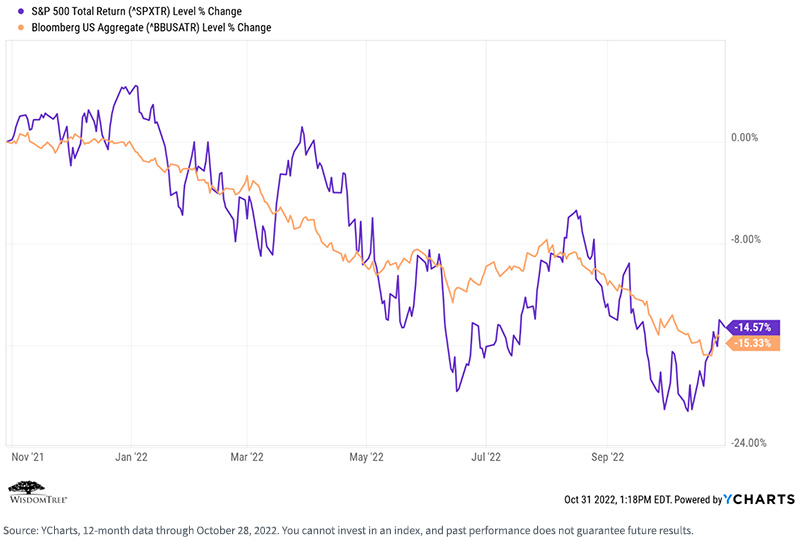
We are receiving an increasing number of inbound calls from advisors asking us, “What else can I put in my portfolio besides stocks or bonds?” The good news is that we have an answer—our Volatility Management model.
Before diving into the details of the model, let’s remind ourselves of some important historical phenomena—alternative or nontraditional asset strategies tend to work best in rising interest rate and rising market volatility environments, which we certainly would argue represent the current market environment.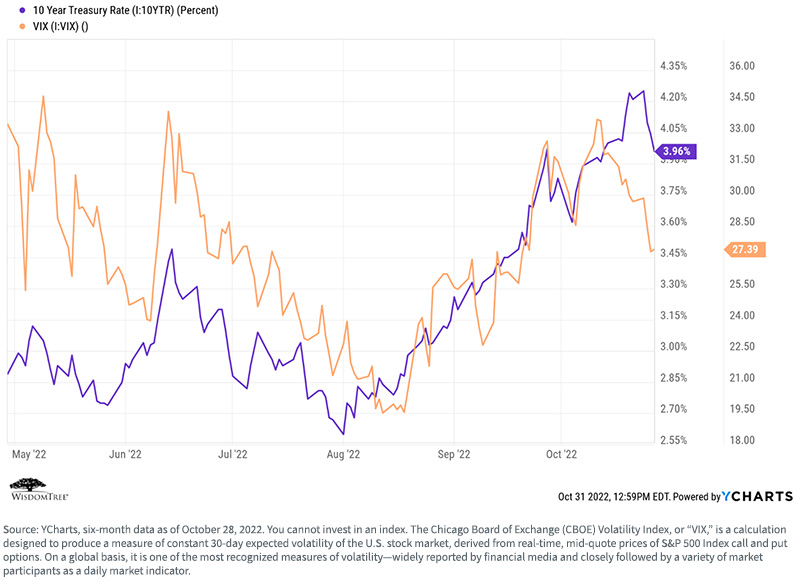
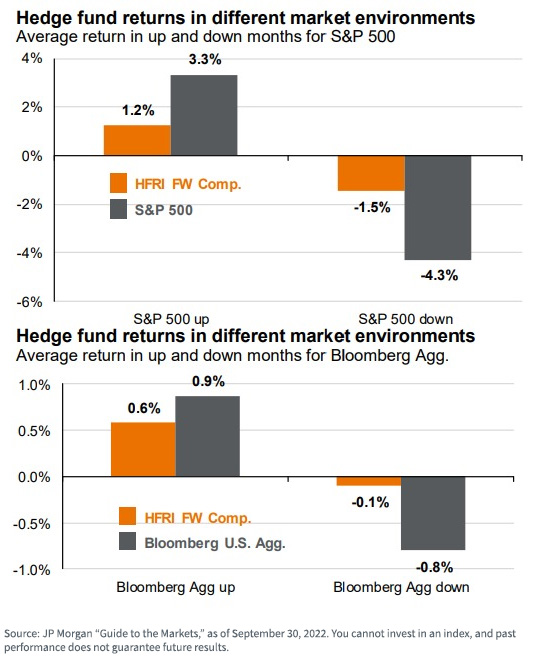
These strategies have additional potential benefits: (1) their correlations to traditional stocks and bonds tend to go down in times of recession, and (2) they tend to perform best in higher inflationary regimes. Again, we think both characteristics are in place in the current market environment.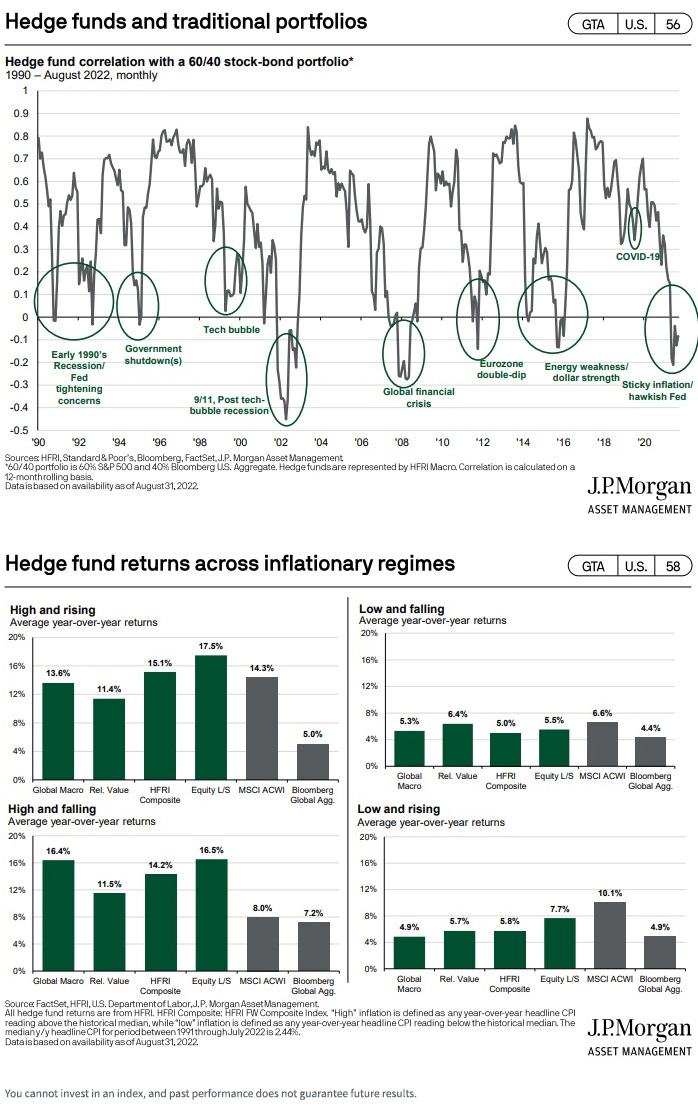
The WisdomTree Volatility Management Model
With this as background, let’s review our Volatility Management (“Vol Man”) model.
As with all WisdomTree models, it has certain fundamental characteristics:
1. It is ETF-centric to potentially optimize fees and taxes.
2. It is “open architecture” and contains both WisdomTree and third-party strategies.
3. There is no strategist fee associated with the model—our revenue is generated only from the expense ratios of the WisdomTree strategies contained within the model.
We currently have equal 20% allocations across five different strategies:
1. Managed Futures, via our own WTMF. We believe all nontraditional or alternative portfolios should start with managed futures, which traditionally have shown almost zero correlation to traditional stocks and bonds, and so may serve as an excellent “anchor position” if the purpose of the portfolio is to improve portfolio diversification and/or add different sources of potential return.
2. “Hedged Equity/Volatility Premium,” via our own put write strategy, PUTW. By selling equity put options, this strategy generates option premiums used to buffer downside market movement. Since higher levels of premium are generated when equity market volatility is high, this strategy helps to buffer returns of traditional long-only strategies (i.e., the premiums collected help offset negative moves in the market).
3. Diversified Arbitrage, via a third-party mutual fund (the only mutual fund included in any of our publicly available models). These types of strategies attempt to capture market inefficiencies associated with things like corporate mergers, convertibles and other “event-driven” corporate activities. Like managed futures, arbitrage strategies have historically tended to have low correlations to traditional stocks and bonds.
4. Equity Long/Short, via a third-party ETF. While these strategies tend to be long the market, their ability to execute short positions may provide mitigation to downside market movement.
5. Short Biased or “Anti-Beta,” via a third-party ETF. As the name suggests, these types of strategies are consistently short the market and seek to capitalize on downward market movements. As you might imagine, this strategy is the best-performing allocation within the portfolio so far in 2022.
This collection of strategies has historically tended to not only have a low correlation between the strategies themselves but, more importantly, has had a low correlation to traditional stocks and bonds. It has provided increased portfolio diversification and, therefore, offered a more consistent overall portfolio performance during bearish or volatile market regimes.
This portfolio has performed exactly as expected throughout turbulent 2022, providing a nice buffer against the dramatic decline in both stocks and bonds throughout the year while at the same time kicking off a very respectable portfolio yield. And, at 74 basis points (0.74%), we believe it is very competitively priced versus other solutions available.
WisdomTree Volatility Management Portfolio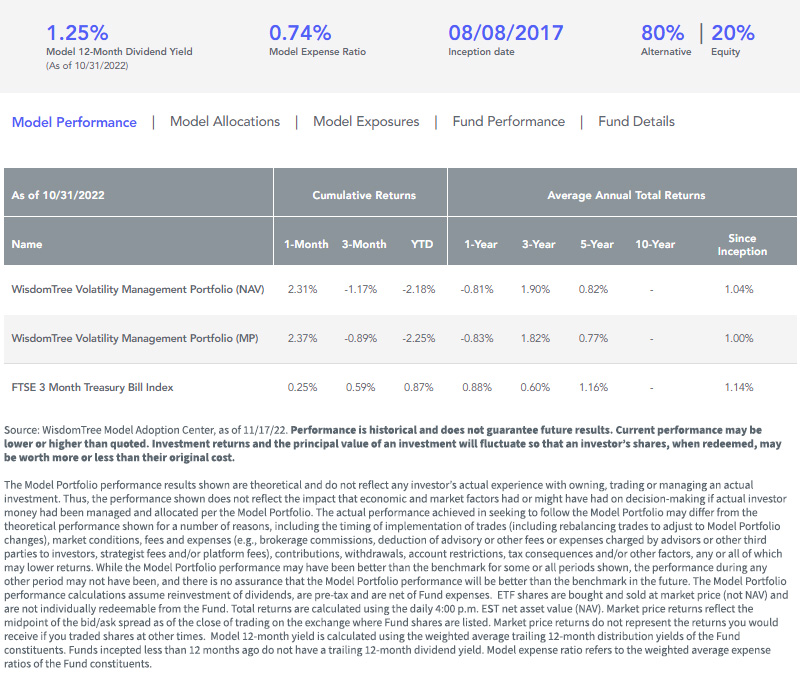 For the most recent month-end and standardized performance of the model and underlying Funds, please click here.
For the most recent month-end and standardized performance of the model and underlying Funds, please click here.
For the 30-day SEC yield for each of the underlying ETFs, please click the respective ticker: PUTW, WTMF, BTAL, FTLS, ADAIX.
As we noted in a recent blog post on client conversations in turbulent times, these are the market times that try investors’ souls—rising rates, increased volatility, a slowing economy, high and “sticky” inflation, a hawkish Fed and negative investor sentiment. What’s not to love, right?
Fortunately, there are things advisors can do to improve portfolio diversification and potentially improve the consistency of performance. Our Volatility Management Model Portfolio is one such potential solution: it was designed to function as a complementary “sleeve” within a traditional stock and bond portfolio with an investment objective of mitigating downside risk.
Financial advisors who register on the WisdomTree website can learn more about this model and how to successfully position it with end clients via our Model Adoption Center.
For definitions of indices and terms in the charts above, please visit the glossary.
Originally published by WisdomTree on 18 November 2022.
For more news, information, and strategy, visit the Modern Alpha Channel.
Important Risks Related to this Article
For financial advisors: WisdomTree Model Portfolio information is designed to be used by financial advisors solely as an educational resource, along with other potential resources advisors may consider, in providing services to their end clients. WisdomTree’s Model Portfolios and related content are for information only and are not intended to provide, and should not be relied on for, tax, legal, accounting, investment or financial planning advice by WisdomTree, nor should any WisdomTree Model Portfolio information be considered or relied upon as investment advice or as a recommendation from WisdomTree, including regarding the use or suitability of any WisdomTree Model Portfolio, any particular security or any particular strategy.
For retail investors: WisdomTree’s Model Portfolios are not intended to constitute investment advice or investment recommendations from WisdomTree. Your investment advisor may or may not implement WisdomTree’s Model Portfolios in your account. The performance of your account may differ from the performance shown for a variety of reasons, including but not limited to: your investment advisor, and not WisdomTree, is responsible for implementing trades in the accounts; differences in market conditions; client-imposed investment restrictions; the timing of client investments and withdrawals; fees payable; and/or other factors. WisdomTree is not responsible for determining the suitability or appropriateness of a strategy based on WisdomTree’s Model Portfolios. WisdomTree does not have investment discretion and does not place trade orders for your account. This material has been created by WisdomTree, and the information included herein has not been verified by your investment advisor and may differ from information provided by your investment advisor. WisdomTree does not undertake to provide impartial investment advice or give advice in a fiduciary capacity. Further, WisdomTree receives revenue in the form of advisory fees for our exchange-traded Funds and management fees for our collective investment trusts.








